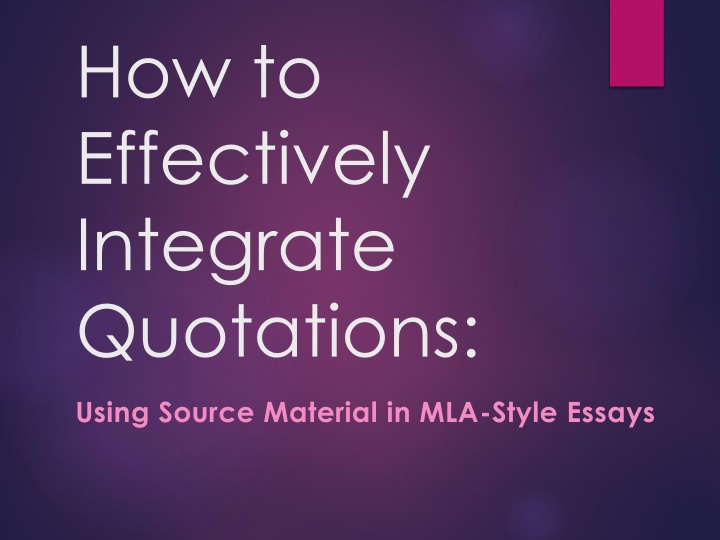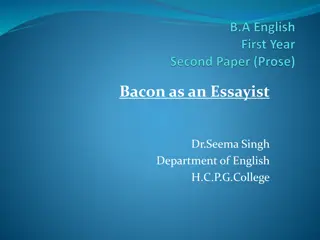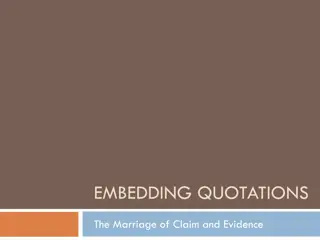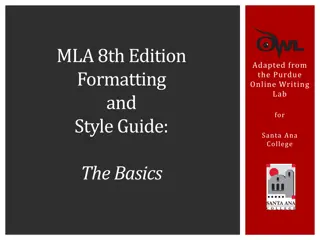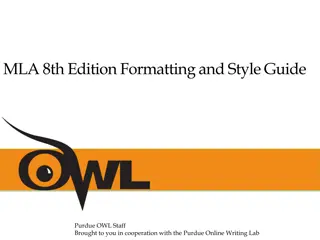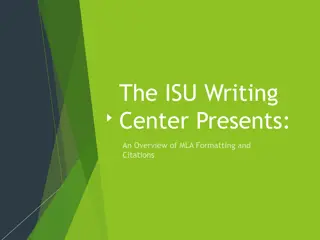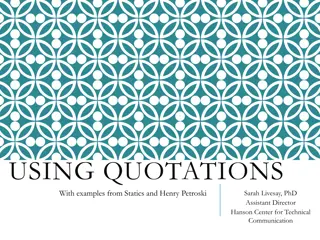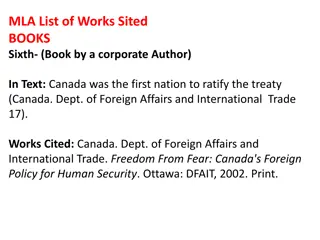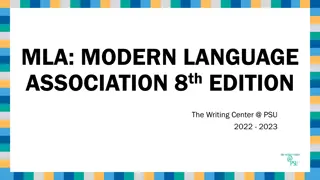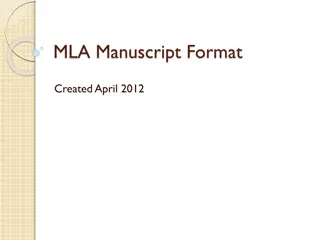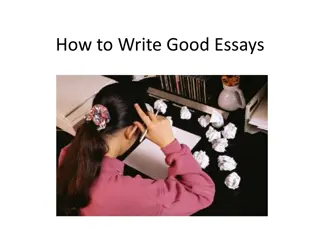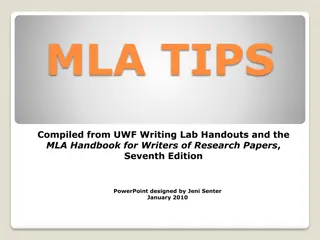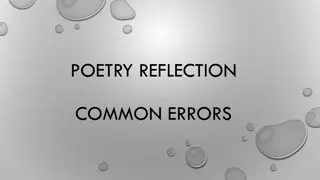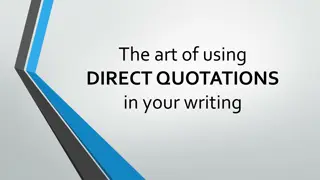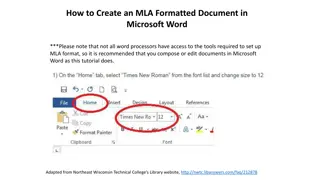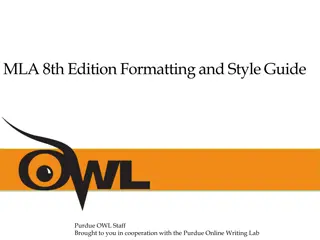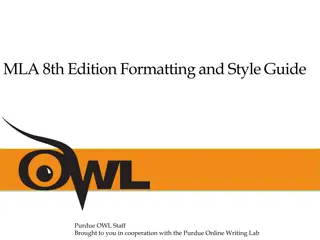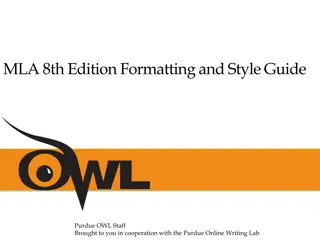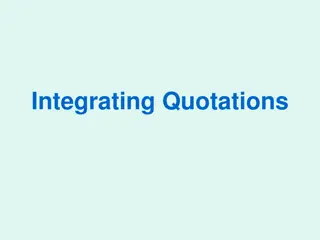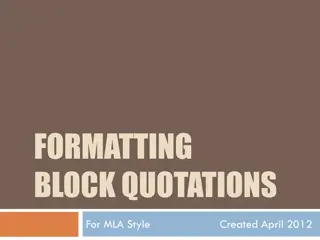Mastering Quotations in MLA-Style Essays
Learn how to effectively integrate quotations in your academic writing by selecting quality sources, understanding their content, and crafting a strong thesis statement to guide your argument. Knowing your sources and their arguments is essential for substantiating your own claims and contributing meaningfully to the academic conversation.
Download Presentation

Please find below an Image/Link to download the presentation.
The content on the website is provided AS IS for your information and personal use only. It may not be sold, licensed, or shared on other websites without obtaining consent from the author.If you encounter any issues during the download, it is possible that the publisher has removed the file from their server.
You are allowed to download the files provided on this website for personal or commercial use, subject to the condition that they are used lawfully. All files are the property of their respective owners.
The content on the website is provided AS IS for your information and personal use only. It may not be sold, licensed, or shared on other websites without obtaining consent from the author.
E N D
Presentation Transcript
How to Effectively Integrate Quotations: Using Source Material in MLA-Style Essays
Have you ever . . . asked someone for something? Who was it? What did you say when you asked? What did the other person say in response? Did you just quote someone?
Well focus on these topics: We ll focus on these topics: Why quote? Which quote? How to build up to a quote Follow-through after a quote
In academic writing, youre In academic writing, you re joining a conversation joining a conversation Make readers familiar with who said what and why Help your audience understand your contributions to the conversation
Choose sources with care Choose sources with care Academic Governmental Political Non-governmental Personal Professional or Trade Commercial
Know Your Source Know Your Source Know the style, tone, and content of each of your sources before using them in your writing. Know the reputation of the author or institution.
Know Your Source Know Your Source Identify the argument of each author s work. Know what you have decided about each work and why.
Lead with Lead with Your Your Thesis Thesis Have your own argument & a working thesis statement. Each paragraph should exist to support your thesis.
Lead with Lead with Your Open paragraphs with your own words. Bring in outside sources to illustrate or support your reasoning. Your Thesis Thesis
Literary example Literary example (text drives analysis) When it comes to the traditional tale of Goldilocks and the Three Bears, we re conditioned to sympathize with the girl because we re human, but really, the girl is a persnickety snot: This porridge is too hot! . . . This porridge is too cold! . . . Ahhh, this porridge is just right, she said happily and she ate it all up ( The Story ).
Here she is in the forest, tired and hungry, and she has to have the temperature just right before she ll eat anything? That is hard to believe. Most people who are very hungry just want to satisfy their hunger. Of course, others will claim that it is all just a lesson for children on the concept of unsuitable extremes, but the lesson is overshadowed by the story of a burglar with poor survival skills.
Science example Science example (argument illustrated by facts) When we look at the stars, we re time travelers going back into history. Prof. Steven Jay Hawkins, lead author of the book Doctor Now, agrees because the light we see today was emitted by distant suns millions, even billions, of years ago, and those stars may have gone supernova since then (249). By studying stars far distant in space, we can see what conditions were like at a distant time, as well, and learn what may be in store for our own sun in the future.
Summaries vs. Paraphrases Summaries vs. Paraphrases vs. Quotations vs. Quotations
Summaries = Little detail, just general idea to offer context/background for reader to understand your argument. Analysis and response call for initial summaries.
Summary Summary Original Text by Ben Yagoda, page 184: Before the eighteenth century, writers and speakers typically referred to an indefinite subject everyone, anyone, a person, or the typical student with a they, their, or them.
Weak Example of Summary Before the 1700s, Yagoda says an uncertain subject used the pronouns they or them (184). Strong Example of Summary An indefinite third-person singular subject was often followed by a plural pronoun until grammarians invented a rule against it (Yagoda 184).
Paraphrases Paraphrases = As detailed as original, but completely reworded and restructured for the same idea. Useful for providing supporting facts or details when a copy of the text is not necessary.
Weak Example of Paraphrase Weak Example of Paraphrase Until the 1700s, authors commonly talked about subjects like everybody, anybody, or a farmer with pronouns that we call plural pronouns today (Yagoda 184).
Strong Example of Paraphrase Strong Example of Paraphrase Traditional grammarians have forbidden us to follow indefinite singular third- person subjects with third-person plural pronouns, yet Yagoda demonstrates that until the contrary rule was created, it was acceptable to English audiences (184).
Quotations Quotations = Exact word-for-word copy of the original Borrows author credibility for your writing Use when the wording is extraordinary (poetic, illustrative) and/or must be seen by your readers. Literary analysis and rhetorical analysis make best use of quotations.
Bad Form = Dumped quote Bad Form = Dumped quote Some authors talk about language in a descriptive way and others are prescriptive. Before the eighteenth century, writers and speakers typically referred to an indefinite subject . . . with a they, their, or them (Yagoda 184). Lynne Truss, meanwhile, likes to tell people where to put their commas.
Smooth quote transitions Smooth quote transitions In contrast to Yagoda s descriptive approach, Lynne Truss, author of Eats, Shoots and Leaves and a self-described stickler (xviii), believes standards of punctuation are abysmal in the UK and US, and her book dictates how English should be written. However, she mistakenly equates punctuation rules with grammar patterns, thus losing credibility (xix). Descriptivists, like Yagoda, are more scientific in their approach to language, but the prescriptivists like Truss get all the media attention and are, unfortunately for teachers, more popular.
Quotations by Themselves Quotations by Themselves Are Not Enough Are Not Enough Prepare readers for a quote. Lead us toward the quotation with a signal phrase and introduction.
Quotations by Themselves Quotations by Themselves Are Not Enough Are Not Enough Represent quotations and their original contexts accurately and with complexity intact. Follow the quote with explanation and relevance to your thesis.
Build up to a Quote Build up to a Quote Topic sentence Your point(s) of departure Introduction Signal phrase Quotation
Signal Phrase Signal Phrase Transitions and introduces Provides author credit, context of the quote In MLA, uses present tense or present perfect tense Verb choice indicates original author s tone and purpose and relates to your tone and purpose
Signal Phrase Examples Signal Phrase Examples As the prominent _________ X puts it, ________. As the prominent professor of English and journalism Ben Yagoda puts it, ________ (##). As Ben Yagoda put it in his Sep. 25, 2010 blog entry, _______.
Signal Phrase Examples Signal Phrase Examples In her book, _______:_________, X maintains that ________ (##). In her book, Eats, Shoots & Leaves: The Zero Tolerance Approach to Punctuation, Lynne Truss maintains that ___ (#). (Graff and Birkenstein 46)
Sentence Structure Variety Sentence Structure Variety ____, writes Gish Jen, novelist and lecturer, is the ____ (#). Writing in the journal __________, X complains that ____________ (##). X agrees when he determines that __________.
Verb Tone Verb Tone In X s view, ____________. According to X, _______. X states, _________. States and asserts are neutral; complains, rants, and is alarmed by denote a more argumentative or negative tone.
Verb Tone Verb Tone X disagrees when she asserts that _______. X complicates matters further when s/he claims _______________. Claims can be neutral like asserts, but it can also cast doubt on the credibility of the claim: She claims she was at the club from 10 to 1 o clock, but I saw her behind the bowling alley at 11 last night.
Quote as little as possible Quote as little as possible In the first chapter, Miss Migglesworth is a vain woman who [stops] in front of shop windows to see how others [regard] her (Logan 15). Logan de-personifies Miss Migglesworth as a kind of animal, describing her voice as braying and honking (85, 114), or in more generous moments as trilling (285).
Choose relevant quotes Choose relevant quotes Select text that truly matches your argument or has a specific relevance to your paragraph.
Relevant quotes In a paper on childhood obesity, having a passage like this doesn t work: Children, especially those ages 10-15, according to the National Fitness Foundation, need regular daily exercise to stay fit and perform well in school (Gerke). The local Parks Department spokesperson says, We are doing everything we can to rebuild the baseball field in time for spring ( NW Update ). Spring is when most kids become more active, but we have to support their fitness year-round.
Relevant quotes Putting a quote next to your own sentences doesn t automatically make the quote relate to your paragraph.
Choose Relevant quotes We are doing everything we can to rebuild the baseball field in time for spring. Imagine this was from an article about a community working to recover from vandalism. Even if you see a connection between kids unable to play at a park and their becoming overweight later, the quote wasn t about that, and you can t force it to become relevant to your argument.
Which supports better? Which supports better? Children, especially those ages 10-15, according to the National Fitness Foundation, need regular daily exercise to stay fit and perform well in school (Gerke). a) Researchers in Texas found a high correlation between 15-year-olds test scores and their levels of activity at age twelve (Van Heusen), and the levels of activity and school performance were corroborated by later studies conducted by Harvard and Princeton (Chen and Tyson).
b) Twelve-year-olds who had 30 minutes of high-intensity or 1 hour of moderate- intensity exercise every day in East Texas middle schools were found to have better test scores and higher GPAs their first year of high school than a matching group of students from West Texas middle schools who did not have a daily PE class (Van Heusen).
Block Quotes: Use Rarely Unless you mean to deeply scrutinize the text of a quote longer than 4 lines, use only short quotes. If you do a block quote, the same framing applies: Signal phrase, quote, follow-up
After a Quote, Smoothly Lead Readers Away Follow every quote with its explanation and significance.
After a Quote After a Quote Show what you want readers to understand about the quote. Quoted statistics? Then show what those stats mean for your argument. An author s words have a certain effect? Explain why that matters according to your thesis.
Example significance of a statistic Example significance of a statistic Researchers have found that extreme stress triggers a physiological response unique to each individual and that what manifests in one person immediately can take up to two years to appear in 8% of the general population (Lippman 465). This indicates that some patients won t begin suffering from a trauma until years later. Because physical reactions to stress can take a very long time to emerge, clinicians need to take a detailed history that goes back two or more years to find patterns of stressors and symptoms.
Follow Quote with Explanation The quote still cannot be left alone as if it says everything by itself. You must follow any quotation with what the author meant in the quoted passage. Summarize what the author is saying.
Explanation Templates Basically, X is warning that_________. In making such a _____, X urges us to ____. X is corroborating the ______ that _______. X s point is that _________. The essence of X s argument is that _____. (Graff and Berkenstein 47).
When X says, _____ (##), he/she means that ______. Use verbs that reflect the actions of the original author. (See lists of verbs after the Works Cited slide)
Transition back to your ideas Transition back to your ideas Show how the quote relates to your argument or point. Engage with your sources: build on them, or challenge and question them.
Follow quotes with analysis Follow quotes with analysis Inventing words is part of the poetic arts, and we can find poetry even in pop. Some of the 1970s most popular songs, such as Van Morrison s Moondance and Steve Miller s The Joker, contain fantabulous invented words on the elusive pompatous of love. Many
a barroom pedant has debated the artists intentions behind these weird coinages, yet the general public has had no problem with enjoying the melody and the gist of the lyrics, and probably never will, because the theme of love like poetry is universal.
Challenge Templates Challenge Templates According to X, _____ (##), yet if this is true, then ______. _______, claims X (###). By doing so, s/he wants us to believe that _____, which would require us to accept that _____, and that is clearly a _____.
Sentence Template Exercise Sentence Template Exercise Refer to the handout for templates to build a sentence around a quotation, summary, or paraphrase.
